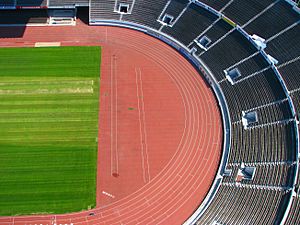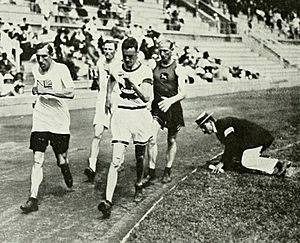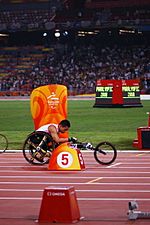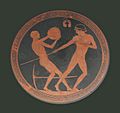Athletics (sport) facts for kids
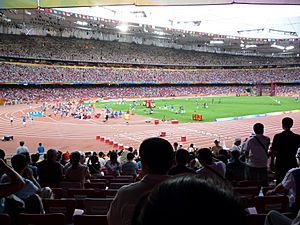
Athletics is a group of sports that includes competitive running, jumping, throwing, and walking. The most common types of athletics competitions are track and field, road running, cross country running, and race walking.
Contents
Events in Athletics
The International Association of Athletics Federations (now called World Athletics) is the main group that runs the sport. They say athletics has six main parts: track and field, road running, race walking, cross country running, mountain running, and trail running. Mountain running was added in 2003, and trail running in 2015.
Most athletics events are individual sports. This means one person competes against others. But in relay races, teams work together. Also, at big international events, athletes' scores are often added up by country to see which country wins.
Track and Field Events
Track and field events started in the late 1800s. They were usually held between students from different educational institutions, military groups, or sports clubs. Athletes can compete in one or more events, depending on what they are good at. Men and women compete in separate events.
Track and field happens both indoors and outdoors. Indoor events are mostly in winter, while outdoor events are usually in summer. These sports get their name from where they are held: a track and field stadium. This stadium has an oval running track and a grassy area in the middle.
Running Events on the Track
Many different running events happen on the track. They are split into three main distance groups:
- Sprints: These are short, fast races.
- Middle-distance: These races are a bit longer than sprints.
- Long-distance track events: These are the longest races on the track.
In relay races, teams of four runners pass a baton to each other after running a certain distance. The goal is to be the first team to finish.
Hurdling events and the steeplechase are special running races. Athletes have to jump over obstacles on the track as they run.
Jumping and Throwing Events
The field events are split into two types: jumping and throwing.
- Throwing events: Athletes try to throw an object as far as they can. Common events include the shot put, discus, javelin, and hammer throw.
- Jumping events: There are four main jumping events:
* The long jump and triple jump measure how far an athlete can jump horizontally. * The high jump and pole vault measure how high an athlete can jump.
Combined Events
Combined events are competitions where athletes do many different track and field events. Their performance in each event adds up to a final score. The decathlon is usually for men, and the heptathlon is usually for women.
Major Track and Field Competitions
The biggest track and field events happen at athletics championships and at multi-sport events like the Olympics. The Olympic athletics competition and the World Championships in Athletics are the highest levels of competition. The Paralympic athletics competition and IPC World Championships in Athletics are for athletes with disabilities.
Many famous athletes in athletics come from track and field. There are also national championships and yearly invitation-only events. These events range from top-level competitions like the IAAF Diamond League to local school events, which help new athletes get started.
Road Running
Road running events are mostly long-distance races. They happen on paved or tarmac roads. However, big races often finish on the track inside a main stadium. Road running is a popular hobby for many people. At the top level, especially marathon races, it's one of the most popular parts of athletics.
Road races can be almost any distance. The most common and well-known are the marathon (about 42 km), half marathon (about 21 km), 10 km, and 5 km. The marathon is the only road running event at the IAAF World Championships in Athletics and the Summer Olympics. There is also a yearly IAAF World Half Marathon Championships. The marathon is also the only road running event at the IPC Athletics World Championships and the Summer Paralympics.
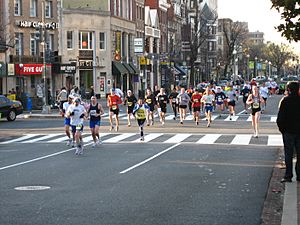
Road running started with "footmen" in the 1700s. These were servants who ran alongside carriages or ran errands for rich people. Rich people would bet on whose footman could run faster. Over time, running became a professional sport, with people training just for these races.
The 1896 Summer Olympics started the modern marathon. This led to more road running races, like the Boston Marathon (first held in 1897). In the 1970s, running became a very popular pastime in the United States. This made road running even more popular for both everyday people and top athletes.
Ekiden races are a type of relay race for road running. They started in Japan and are still very popular there.
Cross Country Running
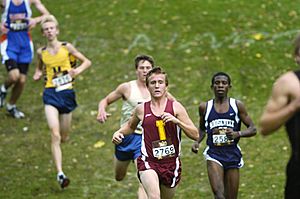
Cross country running is the most natural type of athletics. Races happen outdoors on surfaces like grass, woodland trails, and earth. It's both an individual and a team sport. Runners are judged on their own performance, but their scores are also added up for teams.
These races are usually long distance, 4 km (2.5 mi) or more. They are often held in autumn and winter. Many top cross country runners also do long-distance track and road races.
The first organized cross country race was the Crick Run in England in 1838. The sport became popular in British and American schools in the 1800s. The first International Cross Country Championships was held in 1903. The yearly IAAF World Cross Country Championships started in 1973 and is the highest level of competition.
Cross country races are no longer part of the main Olympic athletics program. They were included from 1912 to 1924. However, cross country has been one of the events in the modern pentathlon since the 1912 Summer Olympics.
A different type of cross country is mountain running. These races include big uphill and downhill parts, making the course even harder.
Racewalking
Racewalking is a special type of walking competition. It usually takes place on open roads, but sometimes on running tracks. Racewalking is the only athletics sport where judges watch athletes' technique very closely.
Racewalkers must always have one foot on the ground. Also, their front leg must be straight, not bent at the knee, when it touches the ground. If they don't follow these rules, they can be disqualified from the race.
Racewalking started with "pedestrianism" in England in the late 1700s. People would bet on who could walk fastest. Some races were very long, like walking 100 miles (160 km) in 24 hours.
Racewalking was added to the Olympics in 1908. The men's 50 kilometres race walk has been in almost every Olympic Games since 1932. The men's 20 kilometres race walk was added in 1956, and the women's event in 1992. Today, common race distances are 10 km, 20 km, and 50 km on roads.
The biggest racewalking competitions are at the IAAF World Championships in Athletics and the Summer Olympics. There's also a special event just for racewalking called the IAAF World Race Walking Cup, held since 1961.
Athletes with Disabilities
Athletes with physical disabilities have been competing in their own international events since 1952. The International Paralympic Committee organizes these competitions, including the Paralympic Games, which started in 1960.
At top-level competitions, athletes are grouped by their disability. This helps make sure the competition is fair. For example, a T12 athlete is a track athlete who has a visual impairment.
Here are some common classifications:
- F = Field athletes (for throwing and jumping events)
- T = Track athletes (for running events)
- 11–13 – Visual impairment. These athletes may compete with a sighted guide.
- 20 – Intellectual disability.
- 31–38 – cerebral palsy.
- 40–46 – amputation, and other conditions (like dwarfism).
- 51–58 – Wheelchair users.
In wheelchair racing, athletes use special lightweight racing chairs. In many big marathons, wheelchair racers often finish faster than runners on foot. This speed can make it tricky for race organizers to set different start times for wheelchair racers and runners. For example, a crash between a wheelchair racer and a top marathoner at the 2013 London Marathon highlighted this issue.
Sometimes, athletes with disabilities compete against able-bodied athletes. Marla Runyan, who is legally blind, ran in the 2000 and 2004 Olympics. She also won a gold medal in the 1500 meters at the 1999 Pan American Games. Oscar Pistorius, who has two amputated legs, competed in the 2012 Olympics. At the 2011 World Championships, he reached the semi-finals in the 400 meters and won a silver medal with South Africa's 4x400 meters relay team.
In Masters athletics (for older athletes), it's more common to make special arrangements for athletes with disabilities. For example, blind Ivy Granstrom set many Masters world records while being guided around the track.
Images for kids
-
A copy of the Ancient Greek statue Discobolus, showing a discus thrower.
-
Fauja Singh, a Masters marathon runner.
-
A typical road running course on the streets of Toronto.
See also
 In Spanish: Atletismo para niños
In Spanish: Atletismo para niños


